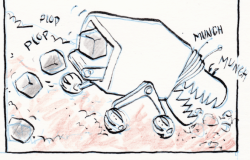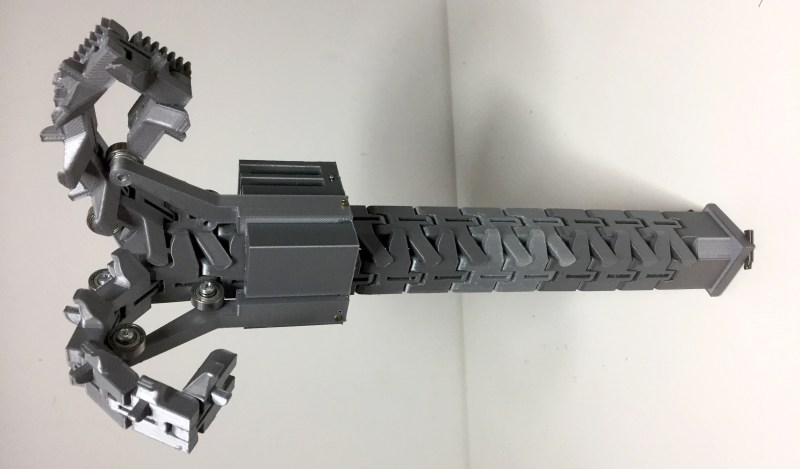While [Elon Musk] and [Jeff Bezos] are working on getting us to Mars and the Moon, [Ronald Jaramillo] is working on building structures once we get there. To that end, he’s been developing the ZBeam, two rolls of links that zip together like a zipper to form a rigid beam.

Initially stored in a compact cube targeted to eventually fit in a CubeSat’s dimension’s, 100 mm x 100 mm x 100 mm, the beam emerges from within the cube and will be able to connect with other cubes to form rigid structures. His hope is that they can one day be made automatically from lunar or Martian regolith (loose surface dirt) munching machines. His current one has 160 mm sides and uses a servo hacked to turn continuously.
In his hackaday.io project logs he shows the trial and error he’s gone through to get to his current stage: experimenting with the links to form a more rigid beam, fine tuning the unreeling of the rolls of links to prevent jamming, adding a safety-ratchet-gear to the gearing to overcome speed issues, and more. He currently 3D prints as many connected sets of links as he can on his Prusa i3, and then manually connects sets together to make a longer chain, but he has his eye on the Printrbot Printrbelt for printing arbitrarily long chains in one piece.
You can see one pretty impressive iteration of the ZBeam in action in the video below and more is on his project page. In fact, the judges for the 2017 Hackaday Prize liked [Ronald]’s projects so much that they designated it as a Best Product finalist.
Deploying large structures in space starting from a footprint small enough to fit in a rocket is a common problem, and it’s one we’ve shown JPL doing an impressive job on with the dish for the RainCube satellite, also fitting in a CubeSat’s dimensions.




















Here’s another one of his videos showing how the chains link together to form a structural beam.
I love these posts, where someone is doing really high level basic research.
https://www.youtube.com/watch?v=D_D9LyOdBhM
How can something basic be high level? It’s either elementary or its not. How is this any more impressive than a snap bracelet?
Hey Mechanicus, you’re highly basic.
For those looking for more info, it is called a rigid chain actuator:
https://en.wikipedia.org/wiki/Rigid_chain_actuator
Have one of those on my Velux windows. Always wondered what it was called. Looks a lot stiffer than the one here.
It’s sort-of rigid, but not really. How do you get the pieces to lock tight?
Closer tolerance and tensioning wires. Autonomous glass fiber production might be a tough challenge.
There is also a similar one called: spiralift telescoping linear actuator.
That is super neat!
U-toob link
https://www.youtube.com/watch?v=xT3xcY1s1kQ
That is straight up witchcraft, and exactly what I was looking for in an application I’m working on.
This is a really interesting project, I don’t quite see why it is a better option for permanent structures on mars than say solid dirt bricks which would be simpler for a machine to make, or poles and joints (ie scaffolding) which would probably be much lighter weight and stronger. Very neat experiment though, the way it rolls up into a small space makes it a really useful actuator.
I had similar thoughts.
This seems to have the same drawbacks as solid bars with none of the benefits. You’re not making a volume savings, not really any weight savings, and if you have to tension them with cables or weld/glue them together after assembly for compression you still have to transport extra material.
I can see the advantage for deploying solar elements, the origami they go through is damned impressive.
Subgrade domes built from regolith bricks or rammed ‘earth’ tubes could work. Starting out you could build in the borrow pit so you don’t have to dig as deep. Then cover the top with a transparent dome to make use of the reduced sunlight Mars gets. Once you get enough habitats built then you could bootstrap into more material intensive, robust designs.
Even bamboo grown on site could provide a decent superstructure, though I don’t know how the reduced gravity affects their growth and subsequent strength. I doubt they’d match Earth grown material 1:1 but still probably strong enough.
Of course getting the first few buildings up is always the hard part.
Rammed earth doesn’t work without water. There’s a clay binding agent that turns it into a semi-cement when compressed.
I was speaking more about the ‘earth bag’ technique which is basically a really long sand bag. These remove most constraints on what you fill them with, though obviously cohesive soil provides better stability. These would also still require an air tight coating or film to be applied to them, but they would provide decent radiation shielding and stability until better options were developed.
That said there are minerals on Mars that could be processed into cement. Magnesium carbonates are more plentiful than calcium versions (opposite of commonality on Earth). Both can be used to make cement, sorrel (magnesium based) cement has better characteristics than normal Portland cement for some applications.
I also don’t a great deal of benefit over solid bars, especially for semi-permanent structures. Why over complicate it? These things are impressive, no doubt about that, maybe really good for applications where you need it to be constantly shape-shifting, but it does look a bit wobbly for a structural element. I wouldn’t want to rely on it if I was going to Mars.
This seems like a zipper mast – See https://www.google.com/patents/US20060261207
or http://zippermast.com/videos/
For structures in low gravity a single curved metal piece like a tape measure might also work.
In addition to the zipper mast, and the spiral-lift, both of which are incredibly cool devices and mentioned above, there is also the foil mast/foil actuator which is constructed like a retracting tape measure but with two metal pieces concave-to-concave. When flattened they roll up like a tape measure, but when expanded into a tube it has good compression resistance. I first saw them used to steer rocket nozzles at the museum in Huntsville.
reticulating splines
This looks like a very simplified version of the Zuse Sprial Tower ( https://www.youtube.com/watch?v=odwgpKRnWM8 )
Pretty neat idea and execution thought :3